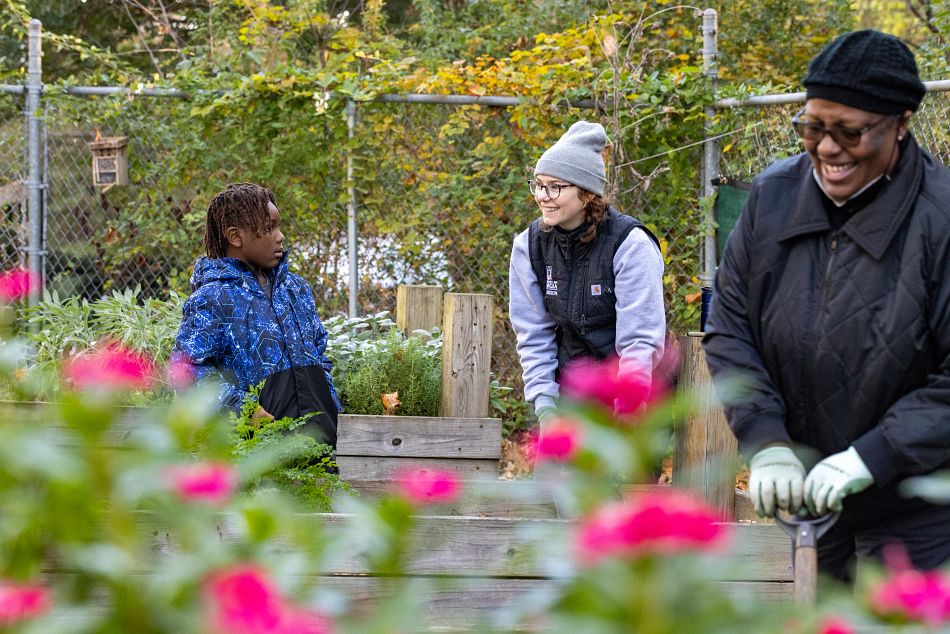This year's Georgia peach crop has had too little cold, too little heat and too little water. But University of Georgia scientists and peach farmers still expect the 1999 peach harvest to be the best since the bumper crop in 1994.
K.Weller, USDA Contact the USDA photo unit for
high-res images. |
| NOT QUITE YET, but Georgia peaches are well on their way. An unusually warm winter was followed a cool spring with too little water had many growers and peach lovers concerned.ÿ But a UGA horticulturist said she expects the largest harvest since 1994 -- a bumper crop. "If everything else goes well, we're expecting 75 percent to 85 percent of a full crop." |
"We're looking at a pretty good crop," said Kathryn Taylor, a stone fruits horticulturist with the UGA College of Agricultural and Environmental Sciences. "If everything else goes well, we're expecting 75 percent to 85 percent of a full crop."
Chill a concern
The lack of chill hours was a big concern, but growers applied a compound called Dormex that substituted for some chill hours.
In Fort Valley, scientists report they got only about two- thirds of the chill hours they needed for many varieties -- about 770 hours versus 1,200 in a normal year. Taylor said the trees set a good flower crop, but the leaves are expanding slowly because of a cool spring.
Dormex speeds up leaf emergence. Once the leaves emerge and begin photosynthesizing, the tree can provide the energy needed to support the developing fruit.
Wild weather
But after the warm winter, Taylor said spring was relatively cool in peach-growing areas. "The cool spring kept the leaves from growing normally. It has some of the farmers holding their breath for the late-season varieties."
Farmer sees difference
Al Pearson of Big 6 Farms in Peach County said he's noticed the trees look different. "They sure don't have the leaves they usually do," he said. "The tree produces the fruit. But it takes the leaves to keep the fruit."
Peach County is in middle Georgia, where farmers produce about 90 percent of Georgia's peach crop.
Pearson said he used Dormex on much of his orchard, but hasn't noticed any real difference in most of the varieties. "We're hoping to see a difference later in the year on the late varieties," he said.
Add water woes
And on top of the too-warm, too-cool problems, Georgia is about 7 inches short on rainfall so far this year. "Our growers are busy irrigating now to develop peaches of good size for the market," Taylor said.
Farmers are also making sure their orchards are clean -- that no extra weeds or grasses take up water the trees need.
Johnny Whiddon, a UGA Extension Service agent in Brooks County, said growers there began picking peaches in the third week of April. "Our crop looks good," he said. "But how we do the rest of the year will depend on the rain we get."
Brooks County is in the second-largest peach growing area in the state, producing about 10 percent of the state's crop. Georgia is the nation's No. 3 peach-producing state with a crop value of $35.2 million in 1997.
Compound helps, but nature most important
Whiddon said most farmers in his county used Dormex on mid- to late-season varieties. Early maturing varieties have lower chill requirements and got enough cold naturally.
"How well we do with Dormex is dependent on timing," Whiddon said. "So we're still waiting to see how those do. But it's looking good."
Pearson said he and his neighboring growers will start picking their peaches in mid- to late May. South Georgia peaches are different varieties with shorter chill requirements and mature more quickly in the warmer climate.
"I'm still a little nervous -- it's still a long time until the season's done," Pearson said. "But overall, I'm real optimistic. I see the possibility for a good crop, probably the best since '94 or '97."







